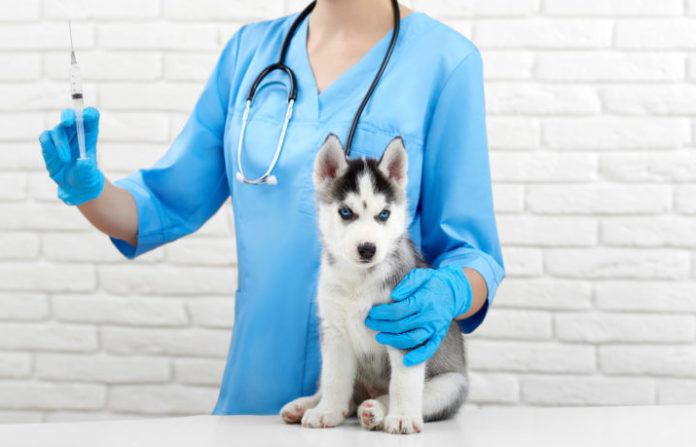Additives and adjuvants in animal vaccines

Most vaccines for dogs and cats contain additional ingredients that can raise the risk of adverse reactions. Let’s look at what these ingredients are, and how you can help keep your pet safe.
The core vaccines you give your puppy or kitten contain antigens that mount an immune response against infectious diseases such as parvo or FIV. But vaccines also contain a variety of additives and adjuvants that can increase the risk of adverse reactions to the shots. It’s important to know something about these additional ingredients, to talk to your vet about any concerns, and to help protect your pet by avoiding unnecessary vaccination wherever possible.
What are vaccine additives and adjuvants?
These ingredients include the carrier molecules and immune stimulants (these are the adjuvants) that are intended to improve the efficacy of vaccines. They also include excipients, the inactive ingredients in vaccines that are present in only very small amounts. They include preservatives like thimerosal (mercury) to prevent contamination; stabilizers (such as sugars or gelatin) to preserve vaccines during storage and transport; and adjuvants like the salts from metals such as aluminum and mercury.
Adjuvants act to accelerate, prolong or enhance the immune response when used together with specific vaccine antigens (e.g. the viral proteins of infectious diseases). While adjuvants are added to vaccines to boost their immune-generating effects, this also increases the risk of adverse autoimmune and inflammatory events following vaccination.
While adjuvants are added to vaccines to boost their immune-generating effects, this also increases the risk of adverse autoimmune and inflammatory events following vaccination.
Lastly, vaccines contain residual trace amounts of the cell culture materials used to grow the antigens, such as egg protein, human serum albumin, fetal calf serum, yeast proteins, and other culture media; as well as ingredients like formaldehyde to kill viruses and inactivate toxins,, and antibiotics (e.g. neomycin and gentamicin) to prevent bacterial contamination.
What kind of adverse effects are known to occur?
Adjuvants have been used relatively safely in human and veterinary medicine for decades, but the debate and controversy about their efficacy versus their safety is not expected to be resolved in the foreseeable future.
Adjuvants can produce numerous adverse effects. But because vaccines are viewed as inherently safe and non-toxic, toxicity studies are often excluded from the regulatory safety assessment of vaccines. Young animals are especially at risk as they are more vulnerable to toxicity than adults, and are regularly exposed to more adjuvants with the typical vaccination series they receive as puppies and kittens.
Adjuvants impact the central nervous system at all levels and can do so by changing expression of the individual’s genes. Further, adjuvants are now known to strongly affect the nervous system-immune axis, which plays a key role in brain development and immune function.
The autoimmune (auto-inflammatory) syndrome induced by adjuvants (ASIA syndrome) was first defined in 2011. Presently, it includes four conditions that share similar signs and symptoms, one of which is from the effects of vaccination. The common denominator in these syndromes is the triggering effect of adjuvants, in combination with other environmental factors along with genetic predisposition. When combined, these factors cause the failure of self-tolerance, which equates to autoimmunity.
Heavy metals like mercury and aluminum are directly involved as well, especially in the thimerosal (mercury)-preserved canine rabies vaccines. The type of allergy or immune response induced by these metals is a delayed-type hypersensitivity that begins around three days but can occur up to 45 days after vaccination. It often manifests as contact dermatitis (skin inflammation), liver or joint damage, seizures, aggression, phobias, or an attack on the red blood cells and/or platelets.
So what’s the solution?
The use of alternative methodologies to protect dogs and cats against common infectious diseases appears to be justified. This is particularly relevant because, unlike human vaccines, veterinary vaccines often contain a large number of substances that act alone or together as immune-stimulating adjuvants.
Unlike human vaccines, veterinary vaccines often contain a large number of substances that act alone or together as immune-stimulating adjuvants.
Reducing the exposure risk of susceptible animals to known infectious agents is a basic epidemiologic principle that should be emphasized. Additionally, over-vaccination should be avoided. Annual boosters are not necessary in most cases, since core vaccines have a much longer duration of immunity than previously thought. Titer testing can determine whether or not a dog or cat is still protected against infectious diseases, so that boosters can be given only when absolutely necessary.
Wherever possible, non-adjuvanted, recombinant, subunit, synthetic (or the DNA/RNA vaccines under development), should be used. However, be aware that all rabies vaccines, as well as vaccines for canine leptospirosis, Lyme, canine influenza, and the injectable form of Bordetella are killed adjuvanted vaccines. Cats have more vaccine options in comparison to dogs. For example, a non-adjuvanted feline rabies vaccine is available. Most vaccines for cats come in MLV combination killed and intranasal versions.
Rabies virus exposure risk and the use of vaccines to prevent this usually fatal disease raises particularly difficult societal and public health issues, especially as these vaccines are among the most likely to trigger significant vaccinosis. For decades, there have been only a few documented cases of rabies in North America in vaccinated, truly immunized dogs and cats, but the disease still exists among wildlife and feral companion animal species. While most pet dogs are vaccinated for rabies, fewer cats have historically been vaccinated until recent laws have required it.
How prevalent are adverse reactions to these vaccine ingredients?
Both veterinary practitioners and pet caregivers are seeing more animals exhibiting signs of immune dysfunction and disease, many of which occur within 30 to 45 days of a vaccination. Vaccines and their adjuvants are implicated as the potential triggering agents in animals genetically predisposed to adverse vaccine reactions, a problem termed vaccinosis.
Vaccine pharmacovigilance is the term used to remind all of us that vaccines carry an inherent, albeit small, risk. As a society, we need to decide what is considered “acceptable harm” from vaccination, and re-examine the number of adjuvants used in veterinary vaccines.
Importantly, although killed inactivated products make up about 15% of the veterinary biologicals used, they have been associated with 85% of post-vaccination reactions. This is mainly due to the acute adverse effects induced by the adjuvants used in companion animal vaccines. No source of an inactivated “killed” combination vaccine is currently available for dogs, although such products without adjuvants, as well as recombinant combination vaccines, are now offered for cats.
Avoiding vaccine additives and adjuvants may seem virtually impossible in some cases, but there are things you can do lessen the risk of an adverse reaction in your dog or cat. Asking your veterinarian about the availability of any non-adjuvanted vaccines (at least for cats) — and most importantly, avoiding over-vaccination — will do a lot to help.



